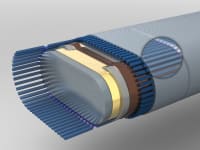Compared to copper, per unit weight, sodium has three times the conductivity, seven times the impulse tolerance, but half the cost. Sodium’s explosive chemical reactivity, low tensile strength, and low melting point have heretofore prevented widespread use. However, my patented designs overcome these problems to create practical sodium wire that is lighter, cheaper, cleaner and safer than copper.
Figure 1: Basic wire structure. A springy flattened microtube with joined layers of tempered beryllium copper and aluminum alloy chemically isolate sodium while increasing wire tensile strength to 1/3rd that of conductively equivalent copper. Insulation reinforcement adds more strength if needed. Insulation microchannels contain fire-extinguishing electrically insulative liquid. Transverse metal bulkheads microencapsulate sodium.
The bimetallic microtube maintains sodium’s shape while melting under intense electrical impulse, during which temperature never exceeds sodium’s 98 C melting point, as resistive heat becomes latent heat of fusion. Even when melted, sodium still has higher conductivity per weight. Copper wire of equal length and weight under the same impulse would rise to 550 C, causing fire.
The prestressed microtube wants to spring out into a voluminous circular shape. However, vacuum inside keeps it flat. When heated, sodium expands more rapidly than the wall. This would cause the tube to become more circular and relaxed. However, bimetallic thermal stresses compensate, maintaining spring force near elastic limit.
Figure 2: Self-repairing feature. If the wire is accidentally cut, atmospheric pressure pushes sodium deep into the expanding released springy microtube. Simultaneously, pressurized liquid extrudes from cut microchannels. Some of the liquid covers the hole, smothering retreating oxidizing sodium.
Figure 3: Cutting through bulkhead. Shallow grooves guide a knife through a soft middle portion of the bulkhead, creating two endplates, obviating sodium exposure. Overstretched wire breaks at the slightly weaker bulkhead center, not through a sodium cell. Air-curable fusible microchannel plugs prevent seepage of insulation from cut ends.
Easily recycled with less energy than aluminum or copper, sodium is also more biodegradable, ultimately forming benign sodium chloride, versus toxic copper salts. Clean nuclear and hydroelectric powered electrolysis currently converts nearby salt into sodium (versus dirty, wasteful copper extraction from distant ore). Salt deposits are ubiquitous and inexhaustible, quality copper ore is not.
Every ton of sodium wire prevents 15 tons of CO2 from copper production. Worldwide, 65 megatons of CO2 annually is directly eliminated by switching to sodium. SO2, acid rain, arsenic, antimony, cadmium, lead, mercury, zinc, and other copper extraction pollutants are also avoided. 9 megatons of weight annually removed from electrical devices saves fuel, further reduces CO2.
Exceedingly soft, sodium easily extrudes (with aluminum bulkheads) into bimetallic microtubes manufacturable by extrusion, electrodeposition, sputtering, ultrasonic welding, or preferably my “microfluidic continuous casting” method (US patent 7,626,122). Sodium Wire LLC is constructing a machine for mass production.
Technically, economically and ecologically superior, sodium wire frees scarce copper for other purposes, enables technologies, saves energy, saves money, reduces pollution and improves the life of every human. See sodiumwire.com for more information, including citations supporting claims in this abstract.
Like this entry?
-
About the Entrant
- Name:David Levine
- Type of entry:individual
- Software used for this entry:Modo
- Patent status:patented








